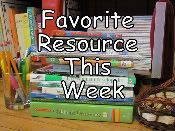 |
| Please visit Learning ALL the Time for links to more favorite resources! |
My favorite resource this week is the simplest, yet most effective, organizational tool I have ever used with my children. It is the Mead Circle the Date Planning Notebook.
I bought one notebook for each boy at Wal Mart. I cannot remember the price I paid but feel certain it was less than $10 per notebook.
Here's how we use them:
- On Fridays, I collect the notebooks and fill in the pages for the up-coming week. I circle the date on each needed page. This is normally five pages (one each for Monday-Friday); however, if we plan to take a day off, I will only circle the date on the number of pages needed for active school days.
- I write in specific page numbers and specific instructions for independent work and a note that says, "See Mom" for lessons we need to complete together.
- I write in daily chores.
- When I have filled in all the assignments, the boys place their planners in a "special spot" on their desks and work down their to-do lists each day.
- Before I declare each school day finished, I read down each list, make sure I have graded all independent work, that all together work is complete, and inspect the quality of their completed chores. If everything is done well, they are FREE!
- When they have finished their Friday work, they bring their planners to me for a conference during which we finish step 5 for that day and restart the cycle with step 1, preparation for the next week.
Here's what I like about these planners:
- They are available in different colors, so each boy has his own. I know the red one belongs to Wilbur and the black one belongs to Orville (as do they).
- The pages are large with lots of room to write...cause I always have lots to say (and write)!
- It is spiral bound so we can easily keep the notebook open to the page for the day and keep all the old pages as records of what we have done. (Can anyone say easy end-of-the-year record?)
- The circle-the-date feature means that we don't "lose" any pages because they are date specific. I don't need to write in instructions for Saturdays and Sundays or days that we are on a school break. All those pages would go unused in a date-specific planner.
- It has made the school day run MUCH MORE SMOOTHLY! Really!!
Here is the best deal I could find online. It is not the exact same planner that we use, and I don't think they are available in different colors. I suggest checking your local Wal Mart or office supply store before buying online, however, should you buy through the link above, Amazon will pay me a small commission. Thanks! (I have not received any other compensation.)
Happy Date Circling!
Dawn


